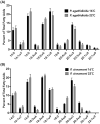The Fatty Acid Methyl Ester (FAME) profile of Phytophthora agathidicida and its potential use as diagnostic tool
- PMID: 34448862
- PMCID: PMC8427540
- DOI: 10.1093/femsle/fnab113
The Fatty Acid Methyl Ester (FAME) profile of Phytophthora agathidicida and its potential use as diagnostic tool
Abstract
Phytophthora diseases cause devastation to crops and native ecosystems worldwide. In New Zealand, Phytophthora agathidicida is threatening the survival of kauri, an endemic, culturally and ecologically important tree species. The current method for detecting P. agathidicida is a soil bating assay that is time-consuming and requires high levels of expertise to assess, thus limiting the analytical sample throughput. Here, we characterized the fatty acid methyl ester (FAME) profile of P. agathidicida. We also compared it with the FAME profile of P. cinnamomi and assessed the efficacy of FAME analysis as a diagnostic tool for detecting the pathogen in soil samples. In FAME analysis, the total fatty acid content is isolated from a sample and converted to FAMEs for analysis, a process that takes less than a day. Unique fatty acid acyl chains can serve as biomarkers for specific organisms. We detected 12 fatty acids in P. agathidicida, two of which (20:4ω6 and 20:5ω3) show promise as potential Phytophthora specific biomarkers. Collectively, these findings advance our fundamental understanding of P. agathidicida biology and provide a promising technique to increase the rate of sample processing and the speed of pathogen detection for P. agathidicida in soil.
Keywords: Phytophthora; Phytophthora agathidicida; diagnostics; fatty acid methyl ester analysis.
© The Author(s) 2021. Published by Oxford University Press on behalf of FEMS.
Figures



References
-
- Beever RE, Bellgard SE, Dick MAet al. . Detection of Phytophthora taxon Agathis (PTA). Landcare report LC0910/137. Ministry for Agriculture & Forestry, Biosecurity New Zealand, Wellington, New Zealand, 2010.
-
- Bellgard SE, Padamsee M, Probst CMet al. . Visualizing the early infection of Agathis australis by Phytophthora agathidicida, using microscopy and fluorescent in situ hybridization. For Pathol. 2016;46:622–31.
-
- Bradshaw RE, Bellgard SE, Black Aet al. . Phytophthora agathidicida: research progress, cultural perspectives and knowledge gaps in the control and management of kauri dieback in New Zealand. Plant Pathol. 2020;69:3–16.
-
- Cavigelli MA, Robertson GP, Klug MJ. Fatty acid methyl ester (FAME) profiles as measures of soil microbial community structure. Plant Soil. 1995;170:99–113.
-
- Cheng MH, Walker TH, Hulbert GJet al. . Fungal production of eicosapentaenoic and arachidonic acids from industrial waste streams and crude soybean oil. Bioresour Technol. 1999;67:101–10.

